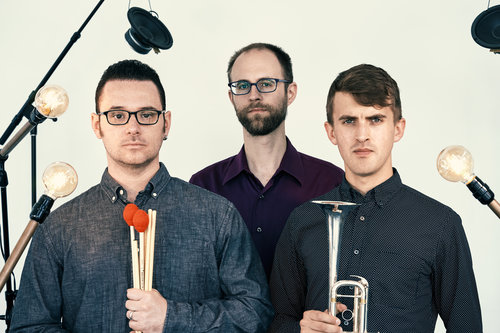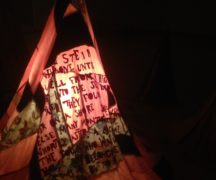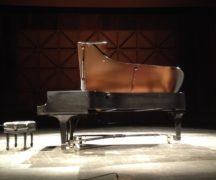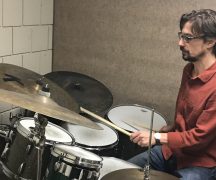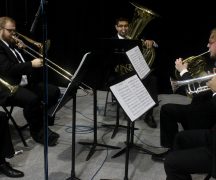By DAVID DUPONT
BG Independent News
Even music that relies on circuitry needs the human touch.
“It’s really that live concert that can make music live and breathe and survive the test of time,” said Keith Kirchoff, of the SPLICE Ensemble. “It’s the performer that’s going to take this music into the next generation. We still need to go to concerts, and it’s this concert experience that’s driven by a compelling performer … that makes it an immediately relatable art form.”
The SPLICE Ensemble will headline the SPLICE Festival this week at Bowling Green State University.
The festival convenes Thursday, Nov. 8 on the Bowling Green State University, and continues through Saturday, Nov. 10. SPLICE will perform a free concert on the last night at 8 p.m. in Kobacker Hall.
The festival is devoted to electroacoustic music. Kirchoff defines electroacoustic music as classical music using electronics that’s “designed for the concert stage, for concentrated listening, intentional listening as opposed to being in the background or for dancing.”
The festival, Kirchoff said, is a mix of performances and workshops. “We wanted to create a ground where the education is an intrinsic part of the festival.”
The festival is one branch of the umbrella SPLICE organization. It started as a one-week summer institute, branched out into the festival, and soon will have an academy program.
The ensemble grew out of the institute, Kirchoff said.
SPLICE was launched about five years ago by composer Christopher Biggs and Kirchoff, a pianist.
“I felt there weren’t very many, if any, opportunities for performers to become comfortable integrating electronics into their performances,” Kirchoff said.
The ensemble is an outgrowth of the festival. Kirchoff and Biggs “wanted to have a performance faculty that was really good at their instruments and really good at electronics.” That, Kirchoff said, turned out to be himself, Kirchoff and fellow institute faculty, Adam Vidiksis, percussion, and Sam Wells, trumpet.
“We really enjoyed working together,” the pianist said. They realized that they had a distinctive sound. Only one composition existed for their particular instrumentation.They set about soliciting composers to write for them. That process was facilitated by the institute and the festival.
The SPLICE Festival is in its second year. Last year it was presented at Western Michigan University where Biggs teaches. Bringing it to BGSU was a natural. Elainie Lillios, of the BGSU composition faculty, teaches at the SPLICE Institute. She’s been “the boots on the ground” to coordinate the event.
“BGSU is fertile ground for a lot of new music,” Kirchoff said. “It’s awesome to me that there’s so much going on.”
Thanks to the Fromm Foundation, Lillios will be writing a major piece for the SPLICE Ensemble.
The trio will perform six pieces on its Saturday recital. Most of them were commissioned specifically for the festival.
Flannery Cunningham’s “Eh/k/oh” has the percussionist and pianist singing in harmony with the trumpet.
Jeff Herriott’s “eyes, sewn, await the sun” started life as a duo for percussion and piano. The composer integrated the trumpet into the work at SPLICE’s request. “It’s very slow and with a lush sound and really gorgeous atmosphere in electronics,” Kirchoff said.
The trio came worked with Iranian composer Bahar Royaee at the institute. “Kücha-lar” explores an Iranian folk song in meditative fashion with Kirchoff plays inside the piano.
Robert Seaback’s “Mutation (as the mark that noise leaves upon presence)” employs interplay between live electronics and processed sound. It proceeds in short spurts, Kirchoff said, with each musician getting a solo.
Silvia Rosani’s “e poi niente” has the percussionist playing large sheets of metal with transducers and microphones attached to capture the sounds moving through the metal. “It’s a really compelling sound world.”
The program will conclude with Igor C. Silva’s “Smart Alienation.” This is the one work not written for SPLICE. It calls for variable instrumentation. It has “intense driving rhythms” synchronized with a video of sporadic images. “It is an intense piece and is definitely becoming a favorite of ours,” Kirchoff said.
Performers working with composers is one of the distinctive features of classical music, which the pianist defines as “that tradition of learned and prepared music.”
What the performer makes from a piece is a different version of the composer’s original. “It’s a beautiful combination of ideas of the composer and the performer,” he said. That collaboration exists even when the two have never met. It exists even, as with a Beethoven sonata, when the performer and composer are separated by centuries. “Beethoven and I are working together,” Kirchoff said. “It’s no less awesome when it’s something written by colleagues today.”

